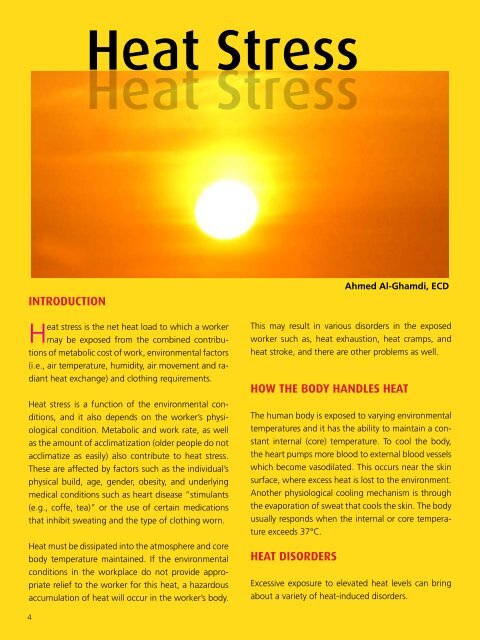Heat Stress - Saudi Aramco
Heat Stress - Saudi Aramco
Heat Stress - Saudi Aramco
You also want an ePaper? Increase the reach of your titles
YUMPU automatically turns print PDFs into web optimized ePapers that Google loves.
PREVENTION OF HEAT EXPOSUREMinimizing heat exposure in the workplace is oneof the best ways to reduce heat stress in workers.Humans have the capability to adapt to heat stress.The acclimatization period usually takes about 5 to 7days.HEAT STRESS CONTROLSeveral control measures can be taken to prevent heatexposure in the workplace. These measures includeengineering controls, administrative control and protectiveclothing.Engineering ControlReduce physical demands of work task throughmechanical assistance.Control the heat at its source through the use ofinsulating and reflective barriers (e.g., insulatefur-nace walls).Exhaust hot air and steam produced byoperations.Reduce the temperature and humidity throughair cooling.Provide cool, shaded work areas.Provide air-conditioned rest areas.Increase air movement if temperature is less than35°C (e.g., use of fans).Administrative ControlThis includes the followings:1. Acclimatization: through graded program for 2weeks for those who are away from work formore than one week. These workers should beacclimatized before resuming work.2. Work scheduling: depending on the nature ofthe load, where rest intervals are recommended.3. Surveillance program: screening heat exposedworkers is vital before onset ofacclimatization and this can be coordinatedthrough a hospital.6
Drinking WaterIn the course of a day’s work in the heat, a workermay produce as much as 2 to 3 gallons of sweat. Itis essential that water intake during the workday beabout equal to the amount of sweat produced. Theworker should drink 5 to 7 ounces of fluids every 15to 20 minutes to replenish the necessary fluids in thebody. Salt tablets are not recommended.adjusted for the contribution of actual exposure toheat stress and clothing, as well as for acclimatization.Tables that are used for such adjustments areavailable in reference materials, which are related toindustrial hygiene and similar practices. It should benoted that full-heat acclimatization requires up to3 weeks of continued physical activity under heatstressconditions similar to those anticipated for thework.Protective ClothingSeveral types of personal protective equipment (PPE)are available to protect workers from heat exposuresuch as:1. Circulating air system: it is based on circulatingair effectively under the clothing which increasesthe amount of convective and evaporativecooling around the body.2. Circulating water system: cool water is circulatedthrough tubes and channels around the body.3. Ice garments: the heat of the body is removedby conduction from the skin to the pockets ofice.4. Reflective clothing: it is the best choice forprotection against radiant heat sources sothe amount of heat reaching the individual isreduced.EVALUATION OF HEAT STRESSOne common method to evaluate heat stress in thework environment is to measure the temperature, velocityand humidity of the air and physical factors ofthe environment and then to assess their combinedeffects on the human body by using appropriate heatstress indices. There are many indices devised to evaluateheat stress. The index that is widely used is thewet bulb globe temperature (WBGT) index. WBGTindex offers a useful indication of the environmentalcontribution to heat stress. It is influenced by air temperature,solar heat, air velocity and humidity.Because WBGT is only an index, values are usuallyReferences1- ACGIH, Threshold Limit Values for chemicalSubstances and Physical Agents, Cincinnati,Ohio (2008).2- Plog, Barbara A., Fundamentals of IndustrialHygiene, 4th Edition, (1996).3- Di Nardi, Salvador R., The Occupational Environment:Its Evaluation, Control, andManagement, 2 nd Edition.4- NIOSH [1986]. Working in Hot Environments,Cincinnati, OH: U.S. Departmentof Health and Human Services, PublicHealth Service, Centers for Disease Control,National Institute for Occupational Safety andHealth, DHHS (NIOSH) Publication No. 86-113.7

















